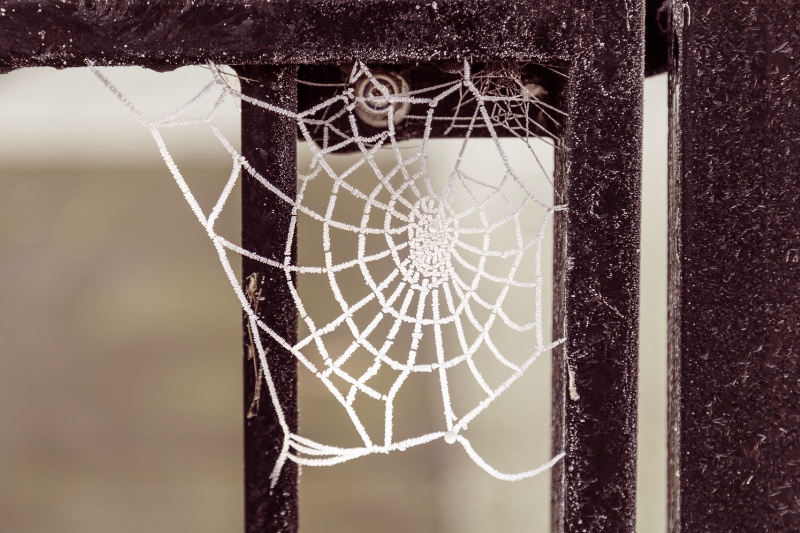The intricate and detailed weave of a living spider web can be quite pretty when it’s outdoors, covered in morning dew and with the sun beaming through its back.
It’s a totally different story when the webs in question are discarded by their owner and end up hanging from your ceilings and plaguing the living daylights out of your shed!
The unsightly, Halloween-vibed nuisances are an eyesore in your house. The cobwebs are grotty-coloured, grip dust like there’s no tomorrow, and can be a pain to get rid of, especially when you’ve got high ceilings!
It’s definitely time to remove Incy Wincy’s empty webs from your property! Find out how to get rid of cobwebs below.
What Causes Cobwebs?
To understand what causes cobwebs, it’s important to know what cobwebs are. So, what are cobwebs?
Cobwebs are old, abandoned spider webs that are made up of lots of sticky threads that were once weaved into a special shape.
The webs often lose their tight structures, become saggy, and hang down from surfaces after they’ve been ditched by their owner.
Live spider webs, in contrast, are quite tight and neat in structure, made from an extra sticky thread, and used daily by spiders. If you see complete/unbroken webs, assume the spider still uses it.
Most spider webs that you see have an intricate radial sort of pattern and can vary in size depending on what type of spider created it.
The goal of a working web is to catch prey and provide shelter to a spider and its eggs.
When the web no longer serves its purpose, and the spider wants to move on to find better food, the web becomes redundant and sits idle in the dark and often untouched areas of a room.
However, the jilted web doesn’t lose its stickiness. It remains sticky, and as it starts to droop (lack of upkeep), it collects airborne dust and dander, which is why the cobweb is so murky looking!
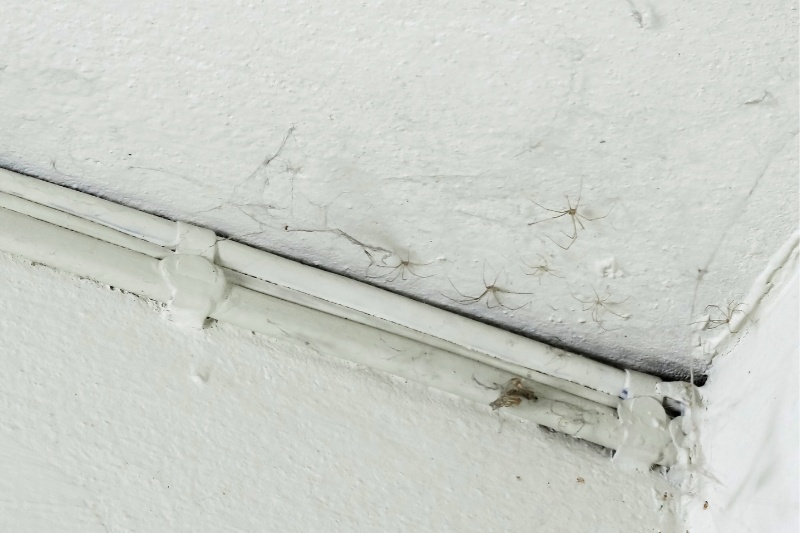
You may be overrun with cobwebs because:
- The spiders in your home may be moving around a lot. Spiders move from one ‘old web’ to a ‘new web’ several times. (Spiders continuously create webs so that they can continue to catch a healthy supply of food). In the moving process, the abandoned but still sticky webs get left behind and gather dust particles, small creatures, and grime instead.
- You haven’t dusted the cobwebs away for a while. So, the webs have been allowed to ‘pile up’ and gather dirt over a long period.
- You don’t hoover enough. Again, the cobwebs have built up, so it now looks like your home is ready for the best Halloween party the world has ever seen!
- You haven’t cleaned certain areas where cobwebs are most likely to appear.
- The house may have been left empty for a long time, so a family of spiders has decided to be the new tenants! If you’ve just moved in, you can clean these cobwebs away.
- There could be lots of food on offer in your house, so you’re attracting spiders. In the process, they build webs and keep moving around your home.
- In the worst case, you may have an infestation of sorts, and you’ll need to call a professional to help you sort the problem out.
Where Are You Likely to Find Cobwebs?

You’ll find cobwebs in lots of different areas in and outside of your house. Below, you’ll find a list of the most common areas.
However, if you do have a cobweb problem in your property, it’ll be fairly obvious because you’ll be able to see the webs.
The most common areas you’ll find cobwebs are:
Indoors
- Corners of rooms
- Ceilings
- Curtain tops
- Top of blinds
- Bookshelves
- Behind furniture
- Under furniture
- Behind photographs

Outdoors
- Outbuildings
- Garage
- Shed
- Window frames
- Doorframes
- Ceilings/roof
Hot to Get Rid of Cobwebs
Option 1: Hoover
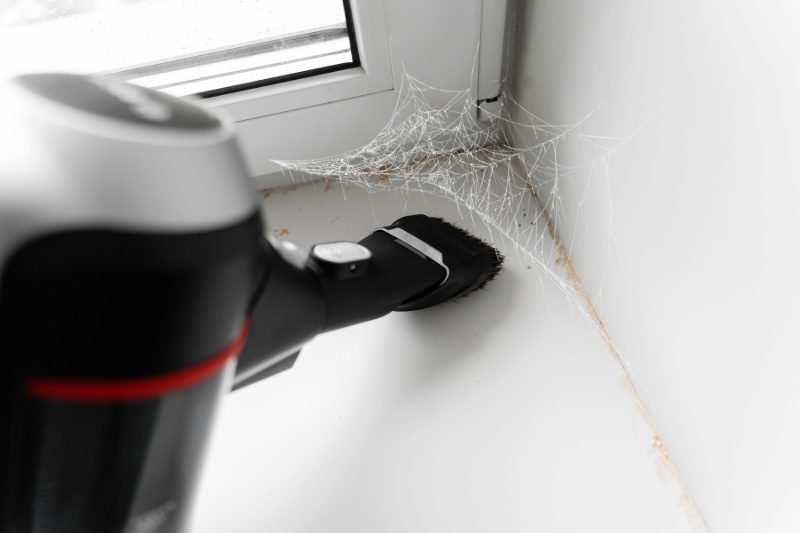
The easiest way to get rid of cobwebs is to hoover them away. You can remove the cobwebs every time you vacuum your home, which should be at least once a week (make it part of your regular cleaning routine).
To do this, you can use a handheld vacuum cleaner to clean more accessible areas and upholstery. And you can use the extendable hoover pole to reach up to the ceilings/corners of rooms.
It’s also worth using all the tools in your vacuum cleaner’s box when cleaning cobwebs because some tools (crevice type) can fit into smaller gaps, while others are better for cleaning softer furnishings (upholstery type).
You don’t need a specific type of vacuum cleaner to clean away common house cobwebs.
Option 2: Dust
Another easy way to remove cobwebs is to dust them away. There are a few different takes on this method. Check them out below:
Duster

When it comes to getting a dusting tool, you should aim to get a telescopic one so that you can clean high ceilings and hard-to-reach areas.
Here are some tools to get you started:
- The Telescopic Extendable Cobweb Dusting Duster from Jazooli can be extended up to 173 cm, has stiff bristles so it can work out the sicky cobwebs, and only weighs 500g, so it won’t be too heavy to lift and move about. The telescopic tool can also be picked up at B&Q!
- You can also get extendable microfibre-headed dusters that can be used to wipe away cobwebs! Healthy Home’s Feather Duster is just one of many examples. This particular telescopic cleaner can be extended to 98 cm, comes fitted with an anti-slip handle, and can be used to clean cars and other surfaces around the home, so it’s multipurpose.
A dusting tool like the ones mentioned above can be used throughout the week to keep cobwebs, as well as general dust, at bay.
The cloth-on-a-mop trick (a DIY approach)
If you don’t want to buy a telescopic duster like those mentioned above, you could make your own version of this tool.
To create this type of gadget, you’ll need to grab a brush and place a microfibre cloth over the top of its handle.
You can secure the microfibre cloth with some elastic bands. When you’re ready, you can use the tool to gently brush the cobwebs off the ceilings/higher surfaces.
In this example, the mop handle acts as a long-reaching device. It may not be the most practical solution, but it’s a great backup option if you don’t have a proper cobweb destroyer at home!
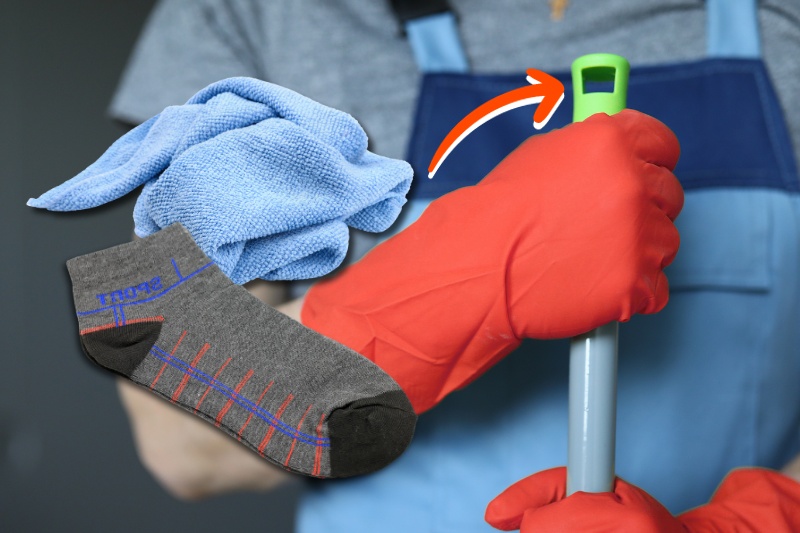
The old sock method
The sock method is similar to the microfibre cloth method above. All you need to do is stick an old sock (preferably clean and neutral-coloured) on the end of a broom handle, secure it down with a few elastic bands, and then start sweeping the cobwebs away.
It’s a cheap solution to your cobweb-related issue and works relatively well!
Slide a sock over your hand
If you want to stick with the sock method but don’t need to clean cobwebs that have settled on high-up surfaces, you could lose the broom handle and put the sock over your hand instead.
In this case, your sock-covered hand can be used to wipe cobwebs off smaller or easier-to-reach surfaces like lampshades and the back of photographs.
This method is more suitable if you need to clean more delicate areas because you’ve got more control over your movements!
Option 3: Lint roller

If you’ve got cobwebs on furniture/upholstery and clothes, you can use a lint roller to remove the webby mess from the items.
Just roll the sticky lint roller over your items, and the cobwebs will be removed from the material.
Option 4: Paint roller and duct tape
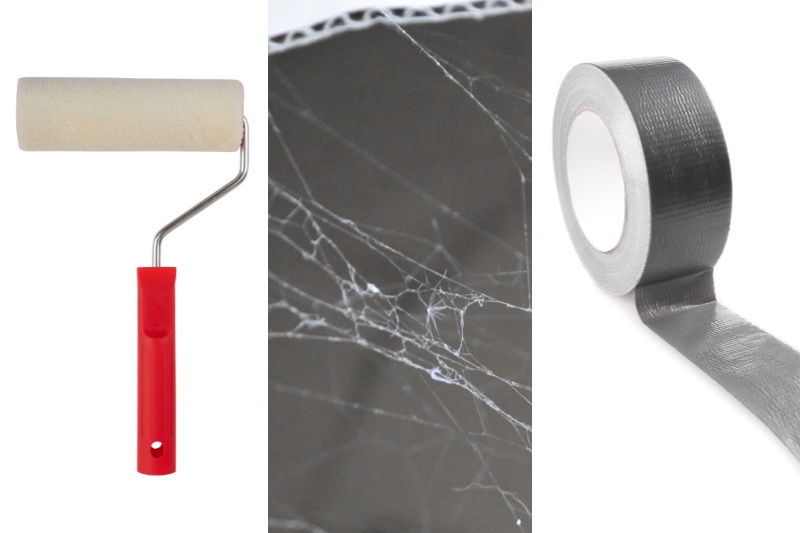
If you’re in a bit of a pickle, you could wrap some duct tape around a paint roller – leaving the sticky side exposed – and use this to roll away the cobwebs from your ceilings and walls.
Just be careful that you don’t press down too hard with the roller because the sticky tape may rip off the paint on the ceilings/walls!
Option 5: Brush and water for cobwebs found outside of the house
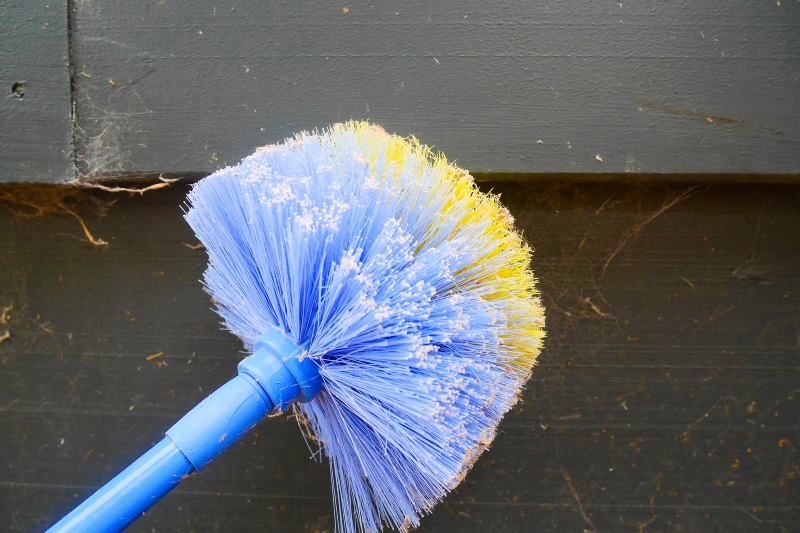
For cobwebs found outside of the house, they can be eradicated using some water and a brush or just a brush.
Blast the cobwebs with a hose and brush the residue off the surface. Or just sweep the webs off the beams and wooden structures found outdoors.
Option 6: Call a professional
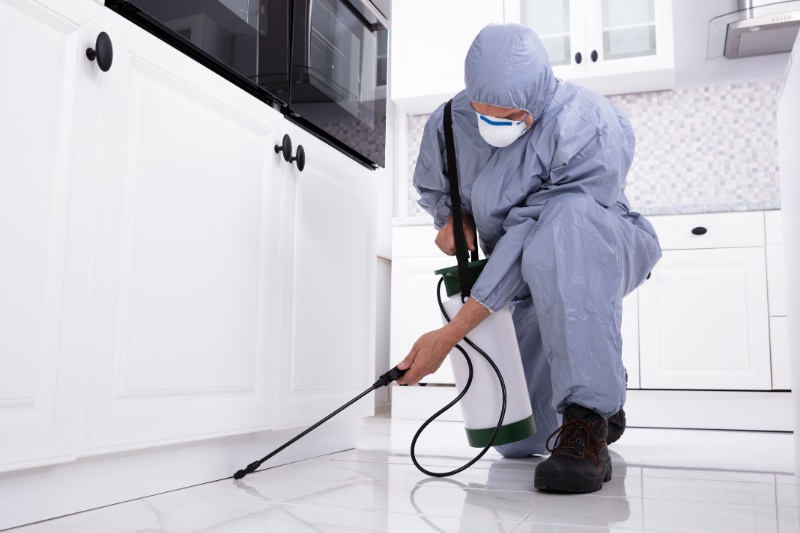
As a last resort, or if you think you’ve got an infestation on your hands, you should call a professional to help you clear the cobwebs away and remove other live spiders/webs you cannot control.
An online search will bring up suitable pest control experts near you. Just choose a reputable company that has lots of positive reviews!
How to Reduce Cobwebs in a Home
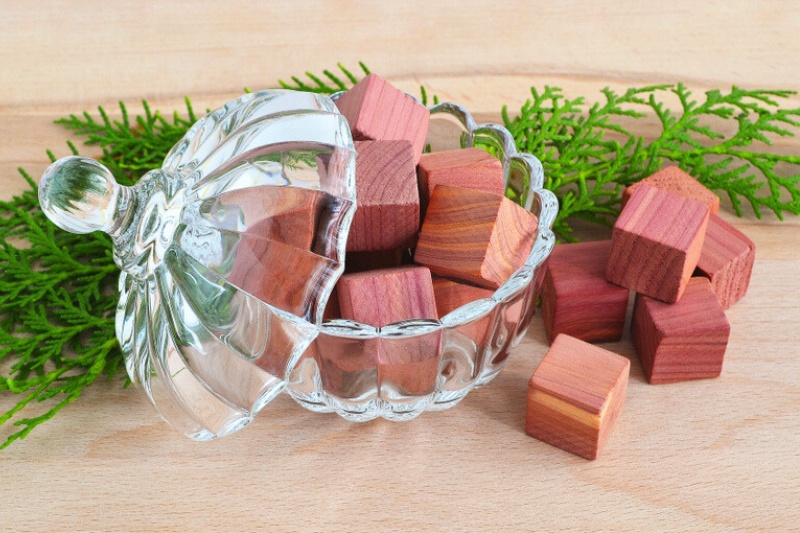
When it comes to reducing arachnid homes in your abode, the first step you must take is to make your house as uninviting as possible to the eight-legged creatures!
You can do this by:
- Clear existing cobwebs/live webs away so the spiders don’t see them and keep coming back.
- To keep spiders at bay, use essential oils (like peppermint, citrus, tea tree, and cinnamon) or vinegar. The odours repel Incy Wincy and Co., so they won’t want to enter your abode. Just create a sprayable solution (essential oil of choice/vinegar and water) and squirt it onto problematic areas. But always do a patch test in case the solution marks your ceiling/wall/furniture!
- Seal holes and cracks so spiders can’t get into your house and make live webs.
- Stay on top of the cleaning. Regularly remove the spider webs and cobwebs you see hanging about inside and outside your home. Make a habit of wiping the webs away and add it to your weekly cleaning routine.
- Another repellent is cedar woodblocks. All you need to do is distribute the strong-smelling blocks around the place, and their aroma will keep the pests away.
- Don’t have too much clutter around the place. Spiders love to lurk in dark, dingy areas, so don’t have too many of these spaces around your home! Keep the clutter to a minimum, and allow lots of air and natural light into your rooms. In turn, you’ll create an environment that’s not quite right for the arachnids.
- Clean the areas where you’re most likely to see cobwebs!
- Get rid of spider eggs (found in live webs) to prevent the spread of spiders in your home. Mix a little bleach and water in a spray bottle and squirt the web with a fine mist to remove the eggs.
- Don’t put plants and cuttings up against the outside walls of your house, as they can attract spiders. Keep the greenery a reasonable distance away from the property.
- Keep strong-smelling plants in the garden. Lavender, mint, and aromatic trees can repel eight-legged intruders.
- Squirt an anti-spider spray around your property like Midas’ Spider Ex Aerosol Spray. The spray should stop spiders from entering your space. (Choose a product that suits the area you need to spray, and always do a patch test).
- Invest in an electronic spider repellent. These tools usually get plugged into a socket, and they leave out high-pitched noises that deter the spiders and other creatures in your home. There are several products you can look into but keep in mind that the devices vary in price, come with different features, and regularly get mixed reviews. So do your homework before you invest in one.
- Avoid attracting moths into the house by switching off the lights. There will be less food for the spiders to eat, so they won’t be overly interested in your home.
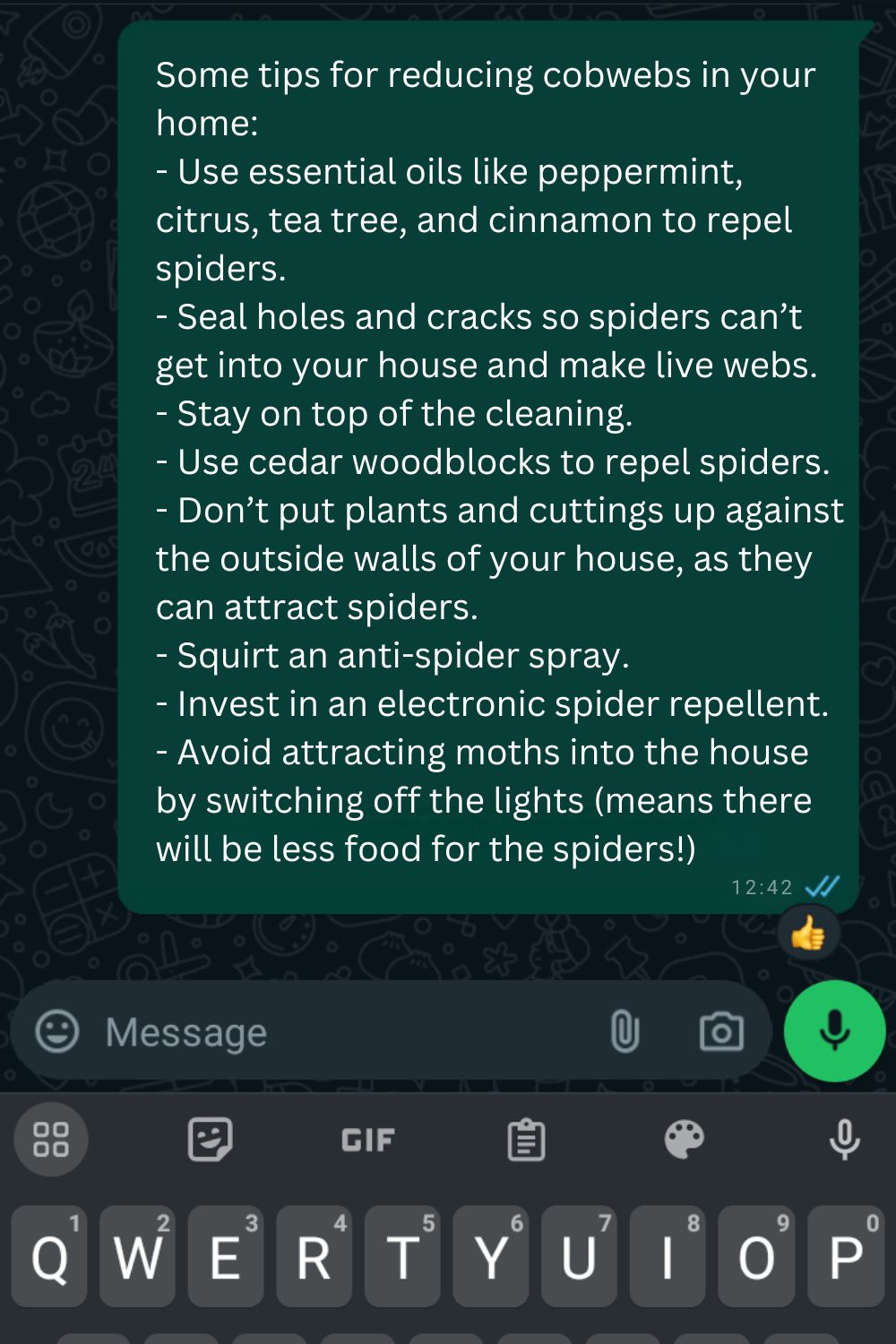

Bethan has a passion for exploring, reading, cooking and gardening! When she’s not creating culinary delights for her family, she’s concocting potions to keep her house clean!
